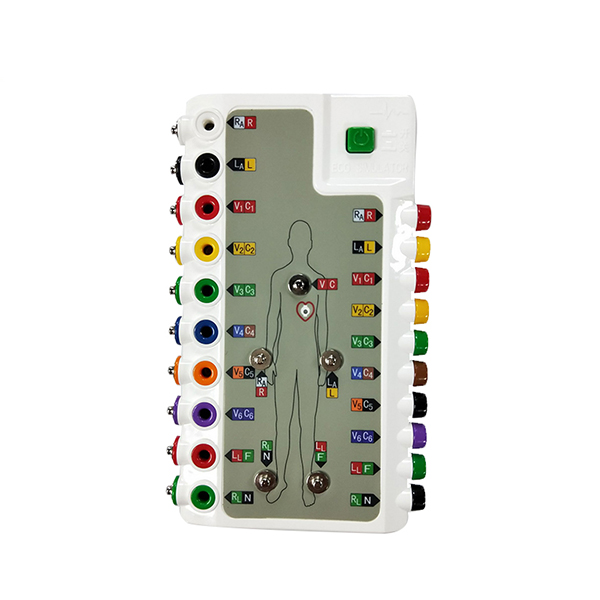Right bundle branch block (RBBB) is a delay in electrical signaling on the right side of your heart. This creates heartbeat irregularities that can be seen on an electrocardiogram (ECG).
Though not a serious problem on its own, RBBB may indicate an undiagnosed heart condition. It usually has no symptoms and does not require treatment except for addressing the underlying cause. Ecg Wireless Cloud

This article discusses right bundle branch block. It explains what RBBB is, what may cause it, and what it may mean for your health.
The heart has two bundle branches, one on each side. The bundle branches are electrical pathways that spread cardiac electrical impulses through the right and left ventricles, ensuring both sides beat in sync.
This signal starts in the sinoatrial (SA) node and tells the upper heart chambers (atria) on each side to contract. The signal then goes to the atrioventricular (AV) node and bundle branches. This prompts the lower heart chambers (ventricles) to contract.
Typically, these electrical impulses travel down both bundle branches at the same time, and the ventricles contract simultaneously.
A block in either bundle branch acts like a speed bump and delays the signal. As a result, one side of the heart contracts slightly later than the other, causing an irregular heartbeat. This loss of normal coordination reduces the heart's efficiency.
A bundle branch block affects how efficiently the heart can pump blood. RBBB is similar to left bundle branch block (LBBB), in which the stimulation of the left ventricle is delayed. Because the right side of the heart moves blood to the lungs instead of the entire body, RBBB carries a lower risk of death than LBBB.
On its own, a right bundle branch block is not usually serious. However, in people with heart disease and a previous heart attack or heart failure, RBBB increases the risk of premature death.
RBBB is sometimes associated with an underlying cardiac or pulmonary condition. A diagnosis of RBBB warrants further testing and evaluation to assess your cardiovascular risks.
Right bundle branch blocks are classified as either a complete block or an incomplete block.
A bundle branch block is more common in the right ventricle. A left bundle branch block, however, is more serious.
The right bundle branch is located within the muscle of the right ventricle and relatively close to the surface of the ventricular cavity. This makes it susceptible to damage and stretching whenever the right ventricle is placed under stress of any kind.
The risk of RBBB increases with age. It occurs twice as often in people over age 65 as compared to those over age 40. It is also more common in men.
Other things that make you more susceptible to RBBB include conditions that affect the right ventricle or increase right ventricle pressure.
Right bundle branch block will often occur with any condition that affects the right ventricle. These conditions can include:
Right bundle branch block may also be seen with any condition that raises the pressure in the right ventricle. These include:
Lung conditions that cause chronic right ventricle pressure elevation can lead to right bundle branch block. These include:
Patients undergoing cardiac catheterization may experience a transient right bundle branch block.
This temporary condition can occur if the catheter irritates the right bundle branch nerves, which are highly susceptible to even small traumas. Transient RBBB usually resolves quickly (within minutes) once the catheter is removed.
However, in people who already have a left bundle branch block, a transient right bundle branch block can cause the heart to stop.
People with LBBB who are having a right-sided cardiac catheterization may have a temporary pacemaker inserted during the procedure to make sure the heart rhythm continues uninterrupted.
A right bundle branch block doesn't usually cause symptoms. While RBBB is characterized by irregularities of your heartbeat, it's not considered arrhythmia and does not cause heart palpitations or other symptoms.
However, RBBB may cause symptoms of heart failure to worsen in some people.
Right bundle branch block is often found incidentally on ECG. RBBB causes a characteristic change on the ECG, so doctors can usually readily diagnose this condition simply by examining the tracing.
In a bundle branch block, the QRS complex—the portion of the ECG that represents the electrical impulse traveling across the ventricles—is wider than normal since it takes longer than normal for the impulse to be distributed.
In right bundle branch block, there is a characteristic pattern this widening takes across the 12 leads (or “views”) provided by a standard ECG. So, it's usually easy to determine the presence of right bundle branch block by simply noting the widening pattern of the QRS complex.
Sometimes, right bundle branch block is part of Brugada syndrome, a rare but potentially life-threatening heart rhythm disorder.
If the ECG in a young person shows a pattern suggestive of right bundle branch block accompanied by an elevation in the ST segments in leads V1 and V2, especially if there also is a history of unexplained episodes of syncope or lightheadedness, Brugada syndrome is considered a possibility.
Anyone who is discovered to have a right bundle branch block needs a medical evaluation that concentrates on signs of heart or lung disease. A chest X-ray and an echocardiogram are commonly used screening tools.
A right bundle branch block usually does not require treatment on its own, though any underlying heart conditions should be addressed.
Heart disease is usually treated with medication and lifestyle changes, such as:
In some cases, a pacemaker may eventually be needed. Situations that may increase the need for a pacemaker include:
Right bundle branch block does not impact life expectancy unless it is due to an underlying condition. In people with cardiovascular diseases such as coronary artery disease or heart failure, complete RBBB is associated with an increased risk of mortality.
Right bundle branch block (RBBB) is an abnormal cardiac pattern seen on an ECG. It does not have any symptoms and is not typically serious on its own.
RBBB indicates a partial or complete block of the electrical impulse to the lower right chamber of the heart. This creates a delay in electrical activation and contraction, which causes the left and right ventricles to beat out of sync and be less efficient.
Right bundle branch block can be a sign of an underlying cardiac or pulmonary condition and warrants further evaluation. RBBB indicates a higher risk for heart disease and should be monitored.
Treatment typically focuses on addressing underlying heart disease through medication and lifestyle changes. In some cases, a pacemaker may be needed.
Get our printable guide for your next doctor's appointment to help you ask the right questions.
Sign up for our Health Tip of the Day newsletter, and receive daily tips that will help you live your healthiest life.
Thank you, {{form.email}}, for signing up.
There was an error. Please try again.
Birnbaum Y, Nikus K. What should be done with the asymptomatic patient with right bundle branch block? J Am Heart Assoc. 2020;9(19):e018987. doi:10.1161/JAHA.120.018987
University of Rochester Medical Center. Health Encyclopedia: About the Heart and Blood Vessels.
Rasmussen PV, Skov MW, Ghouse J, et al. Clinical implications of electrocardiographic bundle branch block in primary care. Heart. 2019;105(15):1160-1167. doi:10.1136/heartjnl-2018-314295.
Alventosa-Zaidin M, Guix Font L, Benitez Camps M, et al. Right bundle branch block: Prevalence, incidence, and cardiovascular morbidity and mortality in the general population. European Journal of General Practice. 2019;25(3):109-115. doi:10.1080/13814788.2019.1639667.
Jeong JH, Kim JH, Park YH, et al. Incidence of and risk factors for bundle branch block in adults older than 40 years. Korean J Intern Med. 2004;19(3):171-178. doi:10.3904/kjim.2004.19.3.171
Kusumoto FM, Schoenfeld MH, Barrett C, et al. 2018 ACC/AHA/HRS guideline on the evaluation and management of patients with bradycardia and cardiac conduction delay: A Report of the American College of Cardiology/American Heart Association Task Force on Clinical Practice Guidelines and the Heart Rhythm Society. Journal of the American College of Cardiology. 2019;74(7):932-987. doi:10.1016/j.jacc.2018.10.044.
Francis J, Antzelevitch C. Brugada syndrome. International Journal of Cardiology. 2005;101(2):173-178. doi:10.1016/j.ijcard.2004.03.068.
Ikeda T. Right bundle branch block: current considerations. Curr Cardiol Rev. 2021;17(1):24-30. doi:10.2174/1573403X16666200708111553
American Heart Association. Lifestyle changes for heart failure.
Wong MM, Arcand J, Leung AA, Thout SR, Campbell NR, Webster J. The science of salt: A regularly updated systematic review of salt and health outcomes (December 2015-March 2016). J Clin Hypertens (Greenwich). 2017;19(3):322–32. doi:10.1111/jch.12970
Sundström J, Bruze G, Ottosson J, Marcus C, Näslund I, Neovius M. Weight loss and heart failure: A nationwide study of gastric bypass surgery versus intensive lifestyle treatment. Circ. 2017;135(17):1577-1585. doi:10.1161/CIRCULATIONAHA.116.025629
Bussink BE, Holst AG, Jespersen L, Deckers JW, Jensen GB, Prescott E. Right bundle branch block: Prevalence, risk factors, and outcome in the general population: Results from the Copenhagen City Heart Study. Eur Heart J. 2013 Jan;34(2):138-46. doi:10.1093/eurheartj/ehs291.
By Richard N. Fogoros, MD Richard N. Fogoros, MD, is a retired professor of medicine and board-certified in internal medicine, clinical cardiology, and clinical electrophysiology.
Thank you, {{form.email}}, for signing up.
There was an error. Please try again.

Handheld Ekg By clicking “Accept All Cookies”, you agree to the storing of cookies on your device to enhance site navigation, analyze site usage, and assist in our marketing efforts.